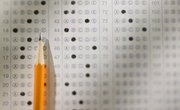The Scholastic Aptitude Test, or SAT is a commonly use tool to help determine which high school students are ready to enter college. Nationwide, universities request SAT scores as part of the application process, and many students sit for the SAT more than once, hoping to get the best scores possible for submission. There are pros and cons to relying on the SAT as the foundation for decision making when it comes to a student's abilities and potential.
Standardized Measurement - Pro
The SAT provides a measurable standard by which to compare a high school student's scholastic knowledge to other students taking the test. Using a grade point average, or GPA, system to determine rank is not as accurate, because each school determines its own ranking. For example, some schools are on a 4.0 system, while others offer classes up to 5.0. There is also room for subjectivity in high school class grading. With the SAT, students either get the answer right or wrong and are scored accordingly.
Rules Out Memorization - Pro
Many questions on the SAT require the student to use a combination of steps and knowledge to answer them. This provides a solid indicator of how the student performs and how strong his deductive skills are. These can be important factors for a student's success at a university. Therefore, the SAT numbers provide valuable information.
Some Areas Overlooked - Con
Students strong in non-traditional areas of intelligence will not display those strengths on the SAT exam, which gives a math and verbal score. For example, students gifted in the dramatic arts, art media or other different academic areas will not be able to showcase their talent. Universities may fail to enroll vibrant, capable and innovative students by placing too much emphasis on SAT scores for admissions. Students strong in non-academic areas may miss out on quality education by not being able to compete on an SAT.
Cultural Considerations - Con
There is a direct correlation between family income and SAT scores according to several research studies, including one by Ezekiel Dixon-Roma, a professor at the University of Pennsylvania. Students who come from homes with incomes below the poverty line typically score several points lower on the SAT than their wealthier counterparts. This may create a socio-economic division in college admissions, which only serves to separate the classes further.
Related Articles
References
Writer Bio
Candace Webb has been writing professionally since 1989. She has worked as a full-time journalist as well as contributed to metropolitan newspapers including the "Tennessean." She has also worked on staff as an associate editor at the "Nashville Parent" magazine. Webb holds a Bachelor of Arts in journalism with a minor in business from San Jose State University.











